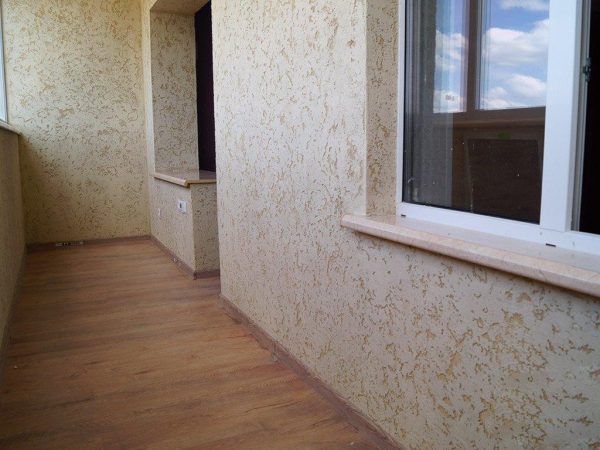Using decorative plaster is a popular method of decorating exterior and interior walls. Its demand is due to aesthetic properties, durability and low price, as well as ease of implementation. The decoration of the balcony with decorative stucco is of particular relevance, because this room is also an integral part of the apartment and directly affects the overall appearance of the interior.
- Features of decorative plasters
- Advantages and disadvantages of decorative plaster
- Types of decorative plaster
- To size
- Large relief
- Small-relief
- In composition
- Mineral
- Acrylic
- Silicone
- According to the invoice
- Pebble
- Marble
- Bark beetle
- Venetian
- Textured gypsum
- Leveling plaster for walls
- Material handling specifics
- Work with brick walls
- Decorative plaster finishing technology
- Plastering tools
- Surface preparation
- Application of the composition
- Final stage
- Features of plastering in cold glazing
- Warm plastering of the loggia
- Installation of insulation for plaster
- Base reinforcement
- Exterior plastering of balconies and loggias
- Proper maintenance of the walls on the balcony

Features of decorative plasters
Plastering walls on a balcony or loggia is one of the most successful finishes, and decorative building mixes are ideal for this purpose. Such materials are a mass based on synthetic or mineral binders, fillers and additives, which after drying forms a coating with the original surface.

Decorative differs from ordinary plaster in composition. The final result is determined by the special components of the mixture: stone chips, dust, various fibers. The purpose of the plasters is also not the same. If simple building mixtures are intended for leveling, then decorative ones close up defects, decorate the surface, and serve as the finishing. The differences between ordinary and decorative plaster lie in the method of application, distribution, decoration, and in many respects they depend on the imagination and artistic taste of the master.
The choice of decorative plasters is huge. If desired, you can turn the loggia or balcony into a beautiful, comfortable room, a comfortable corner for relaxation. In addition to the appearance of the material, when choosing, you need to pay attention to the scope of its application. So, for a glazed, insulated loggia, it is quite possible to use compositions for internal work (any interior plasters). For open and non-insulated balconies, facade mixtures are more suitable, which are not afraid of humidity, frost and temperature extremes.

Advantages and disadvantages of decorative plaster
Decorating the loggia with stucco has a lot of advantages. The main ones are:
- the possibility of use in any conditions, even in the absence of heating on the balcony;
- optimization of thermal conductivity, heat conservation in the room adjacent to the balcony;
- high-quality soundproofing;
- a breathable coating that does not violate the microclimate;
- long service life in comparison with wall-paper and many other decorative materials;
- ease of care, the ability to wash with disinfectant compounds;
- easy color replacement by repainting, a lot of room for designer imagination;
- the ability to combine materials, excellent compatibility with panels, wood, stone, etc .;
- a large assortment and a sufficient selection of price categories (from economy to premium);
- quick drying of the coating;
- resistance to mechanical damage;
- environmental friendliness, lack of emission of harmful substances;
- incombustibility of some types of plaster.

to contents ↑Among the disadvantages of decorative plaster for a balcony, it is worth noting the difficulties with decorating walls for beginners, especially if a complex technique is chosen. In order for the coating to be really beautiful, you will have to carefully study the issue and pre-practice on a rough surface. When mixing, the proportions of the components must be strictly observed, otherwise the composition will not receive the proper properties.
Types of decorative plaster
There are many varieties of decorative plaster, and all of them are well suited for balconies and loggias. Mixtures differ in the size of the filler particles, in the type of base and the texture created.
To size
Depending on the type and fraction of added particles, all plasters can be divided into large-relief and small-relief.
Large relief
They are applied to the surface quite easily, immediately close up the defects remaining after leveling, ideal for beginners. A noticeable relief in such plasters is created by small pebbles, crystals, fibers. The mass can be applied in an uneven layer using improvised tools. After drying, large relief plasters resemble an unprocessed stone.

Small-relief
It’s worthwhile to work with such mixtures if you have some experience, because on the finished fine-grained coating it will be possible to consider every detail. Such plasters are applied only on a carefully leveled base. After drying, the layer is polished, or various methods are used to create a relief on the uncured mixture. Fine-grained plasters are ideal for the manufacture of complex decorative elements.

In composition
All plasters in the construction market are distinguished by the type of main components that make up the composition, which determines their properties and application features.
Mineral
This is the most common type of decorative plasters. Mineral compounds are used much longer than others. They are most affordable, full of the market, 100% environmentally friendly, durable and beautiful. Mineral-based decorative plaster has excellent performance and is non-combustible. The disadvantage of most of these materials is the intolerance of low temperatures, since they begin to become cracked from differences.
The following types of plasters are included in this group:
- Gypsum. They are used as leveling mixtures or applied to give decorative properties. Environmentally friendly, ductile, breathable, easily molded and distributed, helping to create complex reliefs. Quickly gain strength, have high adhesion with most building materials. The disadvantage is the ability to absorb moisture and an early loss of strength due to poor moisture resistance. To improve the properties, hydrophobic additives are introduced into the composition of gypsum plasters, and the finish is covered with moisture-proof paint on top.
- Lime. Such agents also require the introduction of hydrophobic modifiers, although they are more moisture resistant than gypsum. They are considered vapor-permeable, environmentally friendly, plastic, have a bactericidal effect and prevent the growth of mold, fungus, rot. The strength of lime plasters is not too high. Apply them only on glazed loggias.
- Cement-sand.The most wear-resistant of mineral compounds, they are not afraid of dampness, and after the introduction of special modifiers, they can withstand repeated freezing and thawing. Serve for many years, can be used for alignment and as a decorative finish. For finishing work, products based on white cement are usually produced.

Also on sale there are combined decorative plasters: cement-lime, gypsum-lime, cement with the addition of polymers. The latter is recommended if the house is prone to shrinkage or is located in a seismically active zone. The introduction of polymers makes conventional cement plaster more flexible, resistant to vibration and shear. Dyes can be added to any mineral mixture at the kneading stage, although after drying the mass will turn very pale. Therefore, a more popular option is to paint an already dried layer in the selected color.
to contents ↑Acrylic
These plasters are based on acrylic resins, which give powerful moisture repellent properties. After curing, the water-dispersion mass will have high strength, frost resistance, and no reaction to temperature and humidity fluctuations.
Acrylic plasters are not afraid of ultraviolet radiation, do not fade, they are shockproof and able to repel dust, so they can be used even on glazed balconies. The surface is easily washed with water, SMS and other detergent compositions will not spoil it.
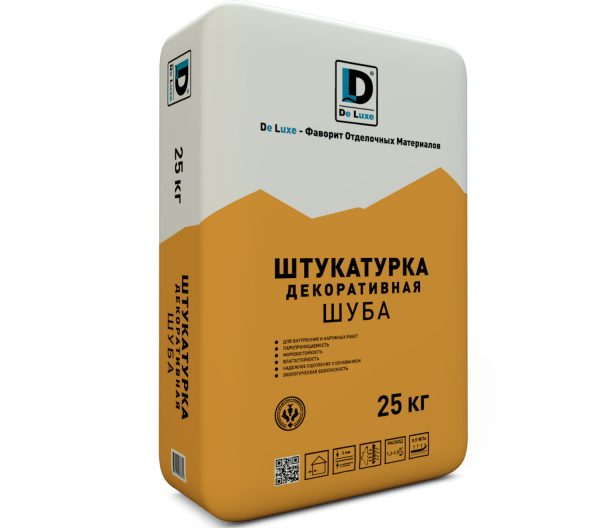
Decorative acrylic plaster is characterized by high elasticity. It is easily applied to any surface (wood, brick, polystyrene foam, aerated concrete block, foam concrete block, mineral wool, OSB), do not crack from vibration. Acrylic-based material is more expensive than mineral, but as it dries it turns into a beautiful, original facing coating. The only disadvantage of acrylic plaster is reduced vapor permeability, so the walls should be further treated from mold and mildew.
to contents ↑Silicone
The composition of such plasters includes siloxane - rubber with a low molecular weight, or classic silicone (organo-silicon polymer). These substances have the highest elasticity, because decorative plasters based on them are often called elastomeric. On a non-hardened plastered surface, any relief can be formed.
Silicone plasters are very durable, serve for decades without loss of aesthetic and strength properties. Mixtures adhere to any kind of substrates, are easy to apply, resistant to all adverse factors, repel water. Despite the moisture resistance, they are considered vapor permeable and do not violate the indoor microclimate.
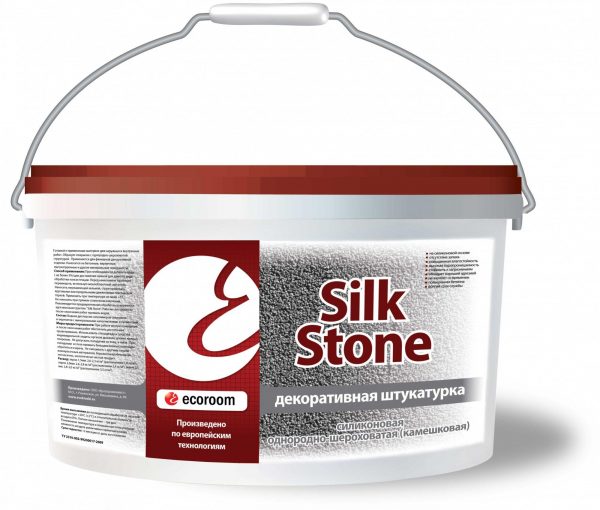
Silicone plasters are suitable even for open balconies and outdoor elements of buildings. Their only drawback is the high cost, therefore, to reduce the cost of the composition, part of the silicone resins are often replaced with acrylics. Also on sale are combined decorative plasters based on silicone and silicate additives (for example, liquid potassium glass), which enhance the strength indicator.
to contents ↑According to the invoice
Designers prefer to work with simulated (structural) plasters, which allow you to create the most unusual decorative effects on the wall. For example, mixes for antique decoration with craquelure effect are popular. The composition of such plasters includes special components that, when dried, cause the top layer to crack, forming a “wrinkle network”. If the cracks are painted with a contrasting color, the result will be amazing.
No less often, plaster with the effect of a reaper fabric is used with the addition of mineral pigments refracted in the rays of light. They make the coating look like silk.“Soft gold” also appears interesting due to the presence of special granules in the composition of the plaster. Other options for decorative mixtures that are suitable for finishing balconies and loggias are described below.

Pebble
The composition of such material contains small stones of strictly calibrated size, and the appearance of the finish will depend on their specific size. Acrylic or silicone is usually used as a cementitious base. Since the mass is applied in a thin layer, the use of cement is impractical: it provides sufficient strength only with a certain thickness of the material. Outwardly, after applying pebble plaster, the balcony will look like sprinkled with pebbles or sand, and color options will not require further processing.
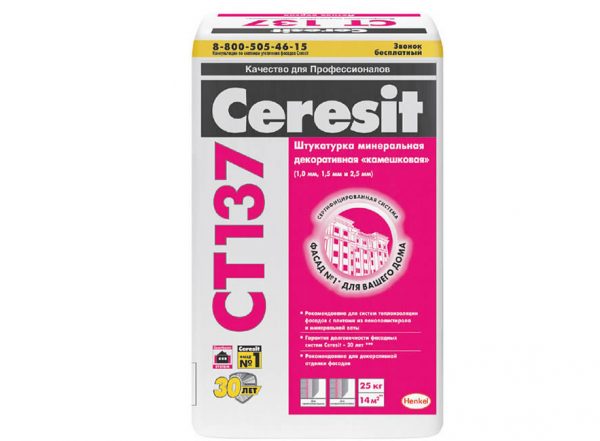
Marble
Marble in the form of crumbs with a fraction of 0.5–5 mm is presented as a filler in such a material. To enhance decorativeness, the plaster contains various dyes, additives to increase strength and elasticity: resins, plasticizers, lime. After drying, the marble plaster is varnished, otherwise it can not be washed, and dust will accumulate on the surface.

Bark beetle
Externally, such a plaster looks like a wood surface eaten by bugs. The grooves can be small or deep, frequent or rare, and the specific effect depends on additional components in the composition, and on the skill of the finisher. Bark beetle plaster works well with any interior, can be tinted before application or painted after drying.

Venetian
Decorative Venetian plaster is considered the most expensive and noble. It is applied in several layers, and in a rather complicated technique, and after drying imitates the surface of natural stone: marble, granite, onyx, malachite. This effect is achieved by introducing into the composition of stone flour, providing highly artistic properties. Venetian plaster can only be used on closed balconies and loggias.

Textured gypsum
Such material is used to create various relief forms. It includes gypsum, as well as sand, pebbles, fibers, mica, threads. The plaster is applied manually, with rags, sponges, textured rollers, and the application technique is complex and requires experience. Since plaster contains gypsum, it can only be used on insulated dry balconies and loggias.

Leveling plaster for walls
Leveling compounds are used to give the walls smoothness, to correct small and large flaws, and to smooth the curvature. They improve the operational characteristics of the walls and, unlike sheets of gypsum board or OSB, occupy a minimum of free space.
On top of the leveling plaster, you can lay a decorative layer or stick panels, tiles, wallpapers. When choosing a material for a balcony, it is worth paying attention to its frost resistance, ability to withstand temperature extremes and high humidity. Usually, cement-sand mortars with the addition of polymers are used as leveling agents. If you have to impose too thick a layer of plaster, reinforcing mesh or even metal profiles are additionally used.

Material handling specifics
Work with leveling plaster is carried out in three stages:
- preparation of walls;
- mixing the solution;
- application of the solution.
During the preparation of the base, the old coating must be removed. If it is planned to install thermal insulation, it is also carried out at this stage.Smooth concrete walls are covered with notches, small chips to make them rough, otherwise the stucco will not hold well. For this purpose, use a metal brush or chisel. After the dust is removed from the wall and treated with deep penetration soil, it is allowed to dry well.
The plaster mortar is kneaded according to the instructions on the packaging, accurately measuring all the components. Immediately knead a small portion of the plaster to have time to apply it before hardening. The composition is thoroughly kneaded, otherwise lumps may remain in it. Add the dry composition to the water, and not vice versa. Otherwise, even the use of a construction mixer will not save the mass from clumping.
For perfectly even plaster application use guide strips (beacons), which will set the desired plane. They are placed every 50 cm, then they are hidden under a layer of plaster. After drying the first layer, it is rubbed with sandpaper or a grater. If necessary, perform another layer. It is desirable that the total thickness of the plaster does not exceed 2-3 cm, which is quite enough to align the walls on the balcony.
to contents ↑Work with brick walls
Often the walls on the balcony, loggias are brick. In this case, work with leveling plaster will have some features. In order to keep the solution firmly held on the surface, all joints are cleaned to a depth of 8–10 mm. To prevent the porous bricks from being saturated with moisture and to prevent the plaster from bloating, the wall is covered with a deep penetrating primer 2-3 times.
After the soil has dried, the plaster is applied in a thin layer (less than 1 cm), with the help of a spatula, a reinforcing mesh is sunk in it, the edges of which are laid with an overlap of 15 cm. Then, as the solution dries, put beacons and make a full alignment of the wall, let it dry and overwrite.

Decorative plaster finishing technology
In fact, working with decorative plaster is not difficult. If you carefully read the recommendations of the masters, correctly prepare the solution, then even a beginner will cope with its application.
Plastering tools
A very necessary device for applying and leveling plaster is a trowel. It is worth choosing a tool of good quality, which is convenient and effective to work with. The following tools may also be required:
- building falcon - “shield” of light metal 40 x 40 cm with a handle in the middle, used to maintain and smooth the plaster;
- spatulas of different sizes from a stainless steel rectangular or trapezoidal shape - are used for applying and smoothing the solution;
- rule 2-3 meters long - helps to fix the applied layer of plaster and tighten it;
- polyurethane grater - depending on the effect, it will smooth or decorate the surface;
- a rubber roller with a pattern or plastic stencils - are used to apply an ornament to a layer of plaster;
- building buckets or guns - needed for faster application of mortar if the surface area is large.

to contents ↑Also, for plastering, you may need a construction plumb, level, mixer or drill with the appropriate nozzle, sponges, brushes, containers for the mixture, mittens for finishing grouting.
Surface preparation
The walls are cleaned from dust, dirt, old finishes. Cracks expand, fill them with cement or gypsum plaster, they also do with pits and chips. Bulging tubercles are ground with an emery cloth or a grinder. A primer with water-repellent properties is applied to the entire surface. Plastering work begins only after the soil has completely dried.

Application of the composition
To begin with, decorative plaster is mixed with water in the right proportion until a homogeneous mass is obtained using a construction mixer. After they type the solution on the trowel, put it on a small section of the wall.Smooth the mixture so that the layer does not exceed 2-3 cm, and for some compositions - 1-1.5 cm (the maximum layer thickness is always indicated in the instructions). Leveling is convenient to do with a grater, wide spatula or rule.
A popular method of applying decorative mixtures is stretching. It is carried out with a trowel, which is held at an angle of 60 degrees. After some drying, the solution is wiped with a metal grater, preparing to apply the finish (front) layer. Usually its thickness does not exceed 2 mm, although the exact parameters always depend on the particular type of plaster.
Immediately after performing the front layer, the formation of the relief begins. For example, an imitation of small pebbles is created in circular motions in one direction. To obtain a structure, the “bark beetle” makes movements that are different in direction and amplitude, after which characteristic grooves remain. Waves are obtained after the mass is superimposed with the same width layers and rubbed with zigzag strokes. Pebble plaster smoothly enough to wipe, and the filler itself will form the desired texture.
to contents ↑Final stage
After the walls have dried, you can proceed to their final decoration. If the composition already contains pigments, you can simply coat it with varnish to give a beautiful shine. An unpainted solution should be treated with a suitable paint using a spray gun, brush, roller. The paint should fall into all the recesses, but it is not recommended to apply it with a too thick layer.
To give an original effect, you can first paint the walls with a sufficiently dark or saturated composition, and then glaze with a translucent light paint. Glaze looks great with a mother-of-pearl compound or metallic paint. After drying, the walls are covered with varnish or wax, which is carefully rubbed into the surface.
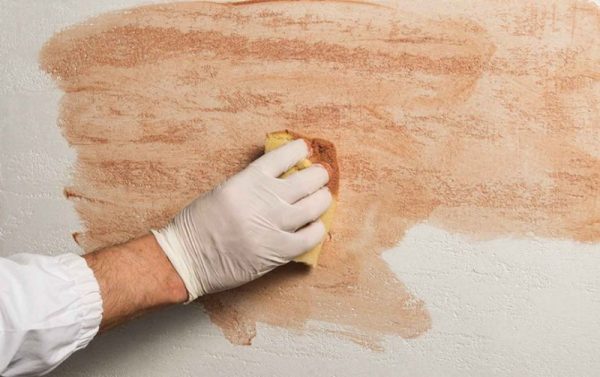
Features of plastering in cold glazing
Under the cold glazing understand the covering of balcony windows with a single glass in order to protect from wind and rain. The room from such a glazing will only become a little warmer (no more than +5 degrees in comparison with the street). When you open the door from the apartment, moisture from the warm air will condense on the walls. This causes the need for their treatment with water-repellent primer before plastering.
You can also use waterproofing plaster mixes, for example, based on silicone. It is important to carry out all work on applying mortars to walls at a temperature of at least +8 degrees. The temperature should remain positive and until the composition is full strength, otherwise the durability of the finish will decrease.
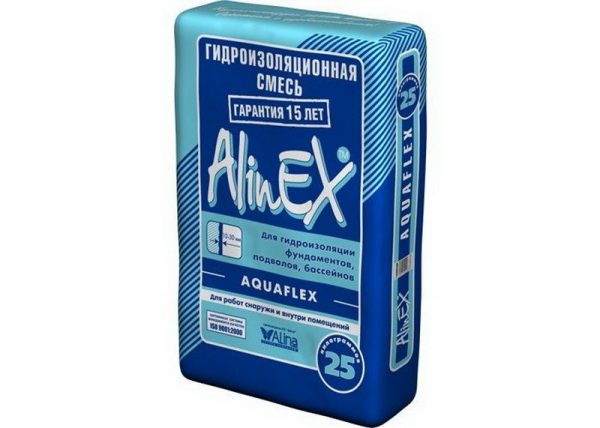
Warm plastering of the loggia
Often, the owners decide to create an additional room on the loggia, so they install a heater on the walls. Start by choosing a quality material. Expanded polystyrene, which is moisture resistant, tough, durable, is best suited for plastering. Mineral wool is not worth buying, otherwise mold will settle on the walls.
Before fixing the insulation, the walls are necessarily prepared - they are cleaned of dust, dirt, impregnated with hydrophobic compounds. Slots and joints are treated with waterproofing, for example, with a mixture of cement with PVA, glued with a special tape.
Especially carefully close the cracks under the windowsill and at the junction of the frame to the side walls. The protruding parts of the foam from the windows are cut with a clerical knife, covered with a water repellent, and also glued with tape.

Installation of insulation for plaster
To fix the insulation, a cement mixture, ready-made mastic or foamed polyurethane adhesive are used. Additional fasteners are special dowels for polystyrene foam (5-6 pieces per square meter). It is good if the insulation sheets have tongue-and-groove joints - they are joined without a gap.
First, they finish the ceiling with plates, then a cold wall under the window, then - side partitions. The wall, which is common for the balcony and apartment, can not be insulated at all.Periodically check the flatness of the plane level, especially at the corners and slopes. If necessary, compensating gaskets are made from the same insulation, which are glued to the back with polyurethane adhesive. Matches of vertical joints between the plates are not allowed, they are mounted only with an offset.
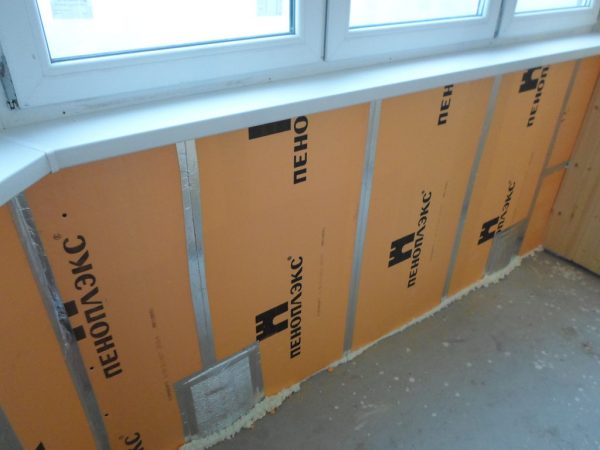
Base reinforcement
After fixing the insulation with a grater, eliminate small differences between the surfaces of adjacent plates. If necessary, put additional dowels. The seams are foamed, mount a self-adhesive window profile with a plastic mesh. This must be done carefully, because tearing and re-gluing the profile is almost impossible.
A layer of reinforcing putty is applied to the mesh. To protect external corners from damage, perforated corners with a grid are fixed, recessing them into the solution. After reinforcing the insulation with a fiberglass mesh over the entire surface of the walls. At the first stage, the corners of the door and window openings are reinforced with “scarves” from the net, glue them obliquely at an angle of 45 degrees. After reinforcing the rest of the walls, gluing fiberglass directly to the layer of plaster. As the mesh is heated, another thin layer of plaster is applied, it is given a day for hardening. Check the finished surface level, if necessary, produce additional local plastering.

Exterior plastering of balconies and loggias
Installation of a layer of external insulation is a great way to preserve the usable area of the balcony itself. In this case, the insulation is fixed from the outside of the building, for which competent specialists with climbing equipment are invited. Independent carrying out such work is unacceptable!

Proper maintenance of the walls on the balcony
Decorative coating does not require special care. Almost all plasters repel water, so surfaces can be wiped with wet rags, wet wipes. Do not wash the plaster with abrasive products that spoil the paintwork and scratch it. If dust sits on the walls, they will always be kept clean by antistatic treatment. In general, facing the balcony with decorative plasters is a very good solution, since it will not cause unnecessary trouble, and the finished coating will look stylish and attractive.




